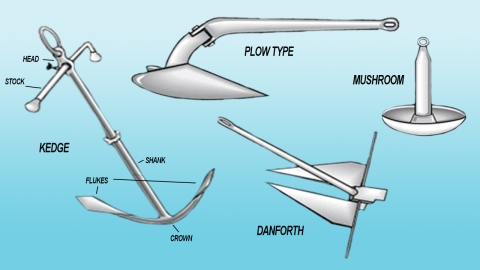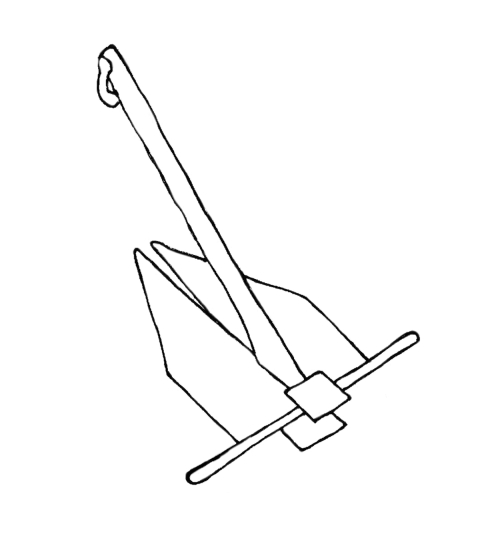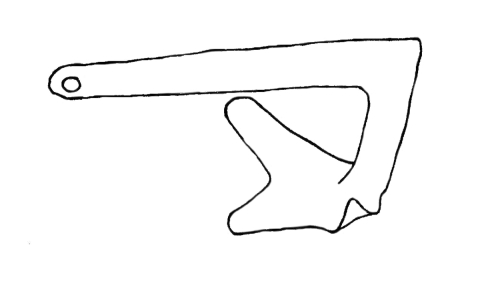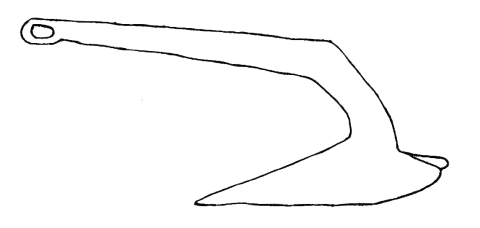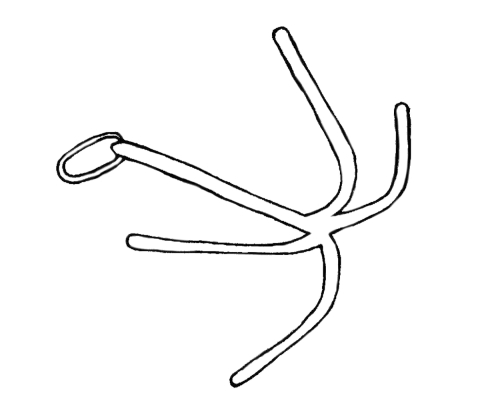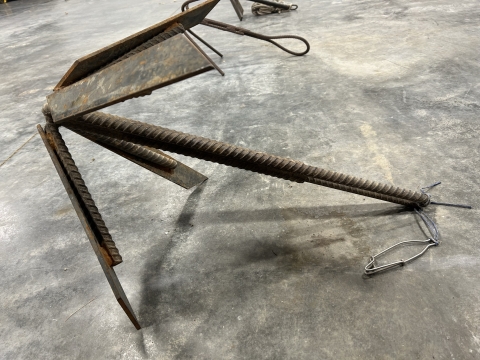Anchors
Description:An anchor is a device used to hold in place fishing gear or vessels by securing gear to the bottom of a water body. Holding gear in place is achieved by 1) anchor weight or by 2) structures that hook or dig into bottom materials or by 3) some combination of weight and grabbing/digging. Anchors come in a variety of configurations and weight, depending upon river bottom type, gear size, and water flow. Typically, anchors for securing vessels are commercially available whereas anchors for fish sampling gear may include locally fabricated designs. As a fisheries biologist, you can experiment with anchor designs, diameters, weights, placement, and number to find an optimal solution. This module concentrates on anchors for fishing gear, not for vessels. Instructional videos will address “ground tackle”, which in addition to the anchor, includes chain and line. | |
Ground Tackle | |
Anchor Types | |
FlukeThe Fluke performs very well in mud and sand bottoms but is not appropriate for other substrates as rocky or hard bottoms. It is a mud/sand only anchor. It has two large triangular flukes that dig into the river or lakebed. The trade name is Danforth. | |
ClawThe claw performs well in most bottom types including mud, sand, gravel, rocky outcrops, and grass. It has a more difficult time penetrating harder surfaces, such as packed clay and beds with dense grass coverage. It sets easily due to the three-claw design that digs in. Keep in mind that the claw has a lower holding power per pound than other anchors and you may need to go with a larger anchor than initially expected. Easy to handle. The trade name is Bruce. | |
PlowPlow anchors provide hold by digging or tilling into the bed. Plow anchors may have a hinged shaft or a solid shaft. Hinged shaft plow anchors have lower holding power and so they typically are heavier. The solid shaft design has good holding power per pound (about 50% more than the Claw). Both hinged and solid models perform well in most bottoms, with poorest performance in rocky situations. Trade names are CQR (hinged shaft) and Delta (solid shaft) . | |
GrapnelA Grapnel anchor with narrower diameter tongs is commonly used to set fishing gear in rocky bottoms. A Grapnel’s holding power comes from hooking onto another object, such as a rock or sunken tree. When it does hook, it can create immense holding power, which can also make retrieving the anchor difficult. Thus, buy or construct a Grapnel with tongs that will bend and allow anchor retrieval. The Grapnel can provide a set in harder sandy bottoms. Adding wider blades to the tongs modifies a Grapnel for use in loose sand or silt. In this design, the holding power comes by digging into the loose substrate and applying larger surface areas. | |
MushroomMushroom anchors are used to provide extra weight to keep hoop net mouths open in slow current or keep leadlines in contact with the bottom. They are used in addition to the main anchor for fisheries gear sets. Mushroom anchors hold best in silt, soft mud, and unpacked sand. For adding weight to keep gear in contact with the bottom, often 1-gallon milk jugs are filled to some level with concrete. An eye bolt is added to allow line attachment. | |
Pound PolePound pole gear consists of a metal rod or stake, a line tied directly to the stake with a Lark’s Head knot or to a metal loop, and a long pole, hollow at one end used for pounding or setting the metal stake in the bed. Pound poles can be used in many bottom types, including silt or rock substrates. They may not hold well in loose, unconsolidated silt. | |
Rode | |
LineThe diameter and type of anchor line is important for successful retrieval and safety. Type means materials used to construct the line and how line fibers are intertwined together (e.g., twisted or braided line). Three-strand twisted or double-braid Nylon is commonly used. Nylon stretches and thus stores kinetic energy.When retrieving a stuck anchor, you may build up a lot of kinetic energy.You do not want the line to snap and recoil back at the crew. Thus, use a sufficiently large diameter line (0.5 inch diameter is suitable).Braided Nylon line can be more comfortable to use, twists and hockles less, and stores easier than twisted Nylon line.The strongest line is Amsteel or Dyneema.Amsteel is extremely resistant to chaffing and fraying, eliminating the need for thimbles and shackles. | |
Chain and Shackles/Thimbles/SwivelsA chain located between the line and the anchor can improve anchor setting and reduce chaffing of the line. The recommended chain length is not based on sampling gear length as when used for boat anchors. Use enough chain to weight the anchor to increase setting likelihood but not to increase labor retrieving the chain. Rode can be fitted with shackles, thimbles, or swivels to connect anchor, chain, and line. Instead of having a chain, line can be tied directly to the anchor by fitting with shackles or thimbles to reduce fraying due to rough edges on the anchor. | |
Portion of ground tackle showing the rode (chain) attached to the anchor with shackles. | |
The chain and line portions of the rode are attached using a shackle and a thimble. Instead of attaching the line to a chain, a line can be directly attached to an anchor instead of a chain with the same shackle/thimble set-up. | |
The chain rode or a chain portion of the rode is attached to an anchor by a swivel. | |
VIDEO: Overview of anchors, line, and pound poles:Anchor and Ground Tackle Overview Anchors are mentioned in other field methods videos as well; those videos show anchors and go over application and deployment/retrieval. | |
Here are some of the anchors depicted in the videos: | |
A modified Grapnel sand anchor. This design has a moveable ring to improve retrieval success. | |
Grapnel-type anchor for use on rocky beds or areas with snags. Made of light-weight rebar to permit bending to facilitate retrieval. | |
Grapnel-type anchor made for holding in sandy/silty riverbeds. | |
The referenced media source is missing and needs to be re-embedded. A heavier Grapnel-type anchor made for holding in sandy riverbeds. | |
DefinitionsGround Tackle: Ground tackle is the term for the system of gear used to hold in position a boat, or in this case, fisheries gear.The system includes the anchor, rode (line and/or chain), and connecting elements (shackles, thimbles, swivels). Rode: consists of a line, chain or a combination of both.A typical rode consists of nylon line with a length of chain between the line and anchor. Shackle: Connects the rode to the anchor. A shackle is a U-shaped metal piece that connects the anchor to the anchor chain or line. Swivel : Performs a similar function to a shackle but allows rotation or twisting of the chain or line without affecting the anchor itself.Usually not needed with freshwater fisheries gear. Thimble: Connects a line to a chain or anchor. A thimble is a grooved ring of thin metal used to fit in a spliced loop of a rope as protection from chafing | |



